Category Books
- Fiction Books & Literature
- Graphic Novels
- Horror
- Mystery & Crime
- Poetry
- Romance Books
- Science Fiction & Fantasy
- Thrillers
- Westerns
- Ages 0-2
- Ages 3-5
- Ages 6-8
- Ages 9-12
- Teens
- Children's Books
- African Americans
- Antiques & Collectibles
- Art, Architecture & Photography
- Bibles & Bible Studies
- Biography
- Business Books
- Christianity
- Computer Books & Technology Books
- Cookbooks, Food & Wine
- Crafts & Hobbies Books
- Education & Teaching
- Engineering
- Entertainment
- Foreign Languages
- Game Books
- Gay & Lesbian
- Health Books, Diet & Fitness Books
- History
- Home & Garden
- Humor Books
- Judaism & Judaica
- Law
- Medical Books
- New Age & Spirituality
- Nonfiction
- Parenting & Family
- Pets
- Philosophy
- Political Books & Current Events Books
- Psychology & Psychotherapy
- Reference
- Religion Books
- Science & Nature
- Self Improvement
- Sex & Relationships
- Social Sciences
- Sports & Adventure
- Study Guides & Test Prep
- Travel
- True Crime
- Weddings
- Women's Studies
Introduction To Sound: Acoustics for the Hearing and Speech Sciences » (3rd Edition)

Authors: Charles E. Speaks
ISBN-13: 9781565939790, ISBN-10: 1565939794
Format: Paperback
Publisher: Cengage Learning
Date Published: March 1999
Edition: 3rd Edition
Author Biography: Charles E. Speaks
Speaks, Charles E., PhD (Univ of Minnesota)
Book Synopsis
This powerful text continues with the same fundamental aim as the previous two editions to not present, but to teach the fundamental concepts of acoustics to students in the speech-language and hearing science. In addition to relocating revised practice problems and answers to a newly created Course Notes and Workbook for Introduction to Sound, the third edition also introduces new features.
David J. Rothman
This third edition book provides information on the concepts of acoustics for those specializing in the speech-language-hearing sciences. As stated in the preface to the first edition, the purpose is to teach the fundamental concepts of acoustics to those involved in the speech-language-hearing sciences. These are worthy objectives. I am not sure that the author's stated objectives are valid, as this book goes beyond an introduction and the fundamental concepts. After reading the book I am not sure who the author is addressing. It may be the advanced student preparing for a career as a speech-language pathologist or audiologist, or an architectural acoustician, engineer, or a pure psycho-acoustician. Does a speech language pathologist or an audiologist have to know about angular velocity to understand phase differences and the effect of these differences on perception? Perhaps the lack of audience focus typifies the problem those of us in the field face: are speech and hearing scientists engineers, psycho-acousticians, or physicists, or a combination of all of these? Certainly, strong background in calculus and physics would be helpful in getting everything there is to get out of this text. If the audience were truly those heading toward the professions of speech-language pathology and/or audiology, I would have preferred that the discussions of sine wave or complex wave summations or phase differences end up by discussing the effect of the different summations or differences on perception. It is important to teach about logs and antilogs before discussing the decibel and to fully describe sine waves before discussing complex waves. However, I would have preferred a fulldiscussion of impedance in one place rather than having to look it up in the index and turn to three different parts of the text to learn all one would want to know about impedance. I did like the "Frequently Misunderstood Concepts" found at the end of each chapter. The author is not only competent to discuss the various topics presented in the text, he does so with clarity and understanding. I am just not sure for whom this book is intended. It certainly is not for the average undergraduate or even average graduate student in the fields of speech-language pathology or audiology.
Table of Contents
| Preface | ||
| Preface to the Second Edition | ||
| Acknowledgments | ||
| Ch. 1 | The Nature of Sound Waves | 1 |
| Ch. 2 | Simple Harmonic Motion | 47 |
| Ch. 3 | Logarithms and Antilogarithms | 103 |
| Ch. 4 | Sound Intensity and Sound Pressure: The Decibel | 131 |
| Ch. 5 | Complex Waves | 185 |
| Ch. 6 | Resonance and Filtering | 217 |
| Ch. 7 | Distortion | 267 |
| Ch. 8 | Sound Transmission | 291 |
| References | 335 | |
| Appendix: Alphabetical Listing of Selected Equations | 337 | |
| Subject Index | 341 |
Subjects
 Music Books
Music Books  Music Theory & Composition
Music Theory & CompositionMedical Books
 Health-Related Professions
Health-Related Professions  Audiology & Speech Pathology
Audiology & Speech PathologyScience & Nature
 Physics
Physics  Acoustics & Physics of Music
Acoustics & Physics of MusicScience & Nature
 All Science & Nature
All Science & Nature  Physics
PhysicsNonfiction
 Medicine
Medicine  Health-Related Professions
Health-Related ProfessionsNonfiction
 Science & Nature
Science & Nature  Physics
PhysicsNonfiction
 Science & Nature
Science & Nature  All Science & Nature
All Science & Nature
